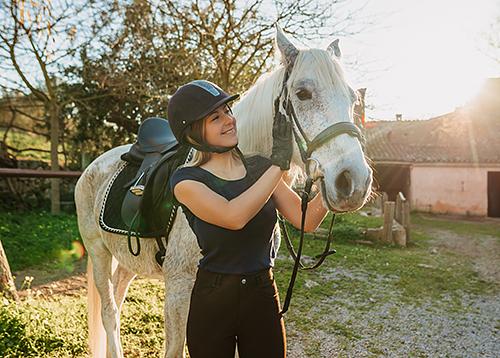Preventing Laminitis in Horses
Jul 12, 2022

As horse owners, we welcome spring and summer because of the green grass and the fact that we will be able to scale back the amount of hay we’re feeding. However, in the excitement of turning our horses out to soak up some sunshine and graze, we must not forget the hazards associated with lush pasture.
While there are many causes of laminitis, overconsumption of green grass has been implicated as one of the most common causes. Lush, rapidly growing grasses contain higher levels of non-structural carbohydrates than mature grasses, and it is the excessive intake of non-structural carbohydrates such as sugar and starch that is problematic for our horses.
You see, in the normal, healthy horse, non-structural carbohydrates are primarily digested in the small intestine. When excessive amounts of these carbohydrates are consumed, the digestive capacity of the small intestine is exceeded, and the undigested carbohydrates spill over into the hindgut.
The hindgut is not designed to digest non-structural carbohydrates; rather, it is supposed to ferment fiber. So, when these carbohydrates reach the hindgut and undergo fermentation, the pH of the hindgut is altered, and the activity of normal microbial populations is disrupted. The disruption of the microbial population results in a release of toxins from the microbes that will eventually reach the bloodstream. Once in the bloodstream, those toxins set off a cascade of events that alter blood flow to the laminae in the hoof, initiating laminitis or inflammation of the laminae.
In the hoof, laminae are the finger-like projections that connect the hoof wall to the coffin bone. When blood flow to the laminae is altered, the laminae begin to degrade and the structural support they provide to the coffin bone weakens, allowing the coffin bone to rotate downward or sink. Rotation of the coffin bone is referred to as founder, and in severe cases, the coffin bone can penetrate the sole. While laminitis can affect all four feet, it is most commonly seen in the front feet, as the horse bears more than 60% of its body weight on its front quarters.
While cereal grains such as corn, barley, or oats contain more non-structural carbohydrates than forages, horses typically consume substantially more forage than cereal grains - especially if it’s their first opportunity to graze fresh pasture in several months. Non-structural carbohydrate content in pastures varies among seasons but tends to be highest at times when the forage is rapidly growing (spring or late fall).
So, one measure in preventing laminitis is to manage your horse’s access to and excessive intake of nonstructural carbohydrates. Given this, we recommend that you gradually introduce your horses to spring pastures, since they have not been eating fresh forage for several months. Begin with just a few hours each day and gradually increase your horse's access to pasture over the course of 2-3 weeks. Feeding hay before turnout can also help reduce pasture intake by increasing the horses gut fill.
Horses that have foundered in the past are often predisposed to laminitis, so for those horses, consider limiting their access to fresh pasture to a few hours per day until the forage is more mature, as immature, rapidly growing forages are high in non-structural carbohydrates.
Any change in a horse’s diet should be done gradually to allow the microbial populations a chance to adapt. Forage, particularly fresh pasture, is no different. While it requires more management for a couple of weeks each spring, limiting your horse’s access to lush green pasture is a much better alternative to managing a lifetime of laminitis.
For additional help or feeding recommendations for horses suffering with laminitis, visit your local Co-op. For more content like this, check out the latest issue of the Cooperator.